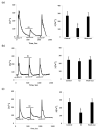Interaction between P2X3 and oestrogen receptor (ER)α/ERβ in ATP-mediated calcium signalling in mice sensory neurones
- PMID: 22175770
- PMCID: PMC3319164
- DOI: 10.1111/j.1365-2826.2011.02272.x
Interaction between P2X3 and oestrogen receptor (ER)α/ERβ in ATP-mediated calcium signalling in mice sensory neurones
Abstract
Emerging evidence supports a role of purinergic P2X3 receptors in modulating nociceptive signalling in sensory neurones. Previously, we showed that dorsal root ganglion (DRG) neurones (L1-S1) express both oestrogen receptor (ER)α and ERβ receptors. In the present study, we investigated the expression of P2X3 receptors and the effect of 17β-oestradiol (E(2)) on the ATP-induced [Ca(2+)](i) increase in DRG neurones collected from C57Bl/6J, ERα knockout (KO) and ERβKO mice. Our data showed a significant decrease for P2X3 in ERαKO (all levels) and ERβKO (mostly observed in L1, L2, L4 and L6). Furthermore, E(2) (100 nm) significantly attenuated the ATP (10 μm)-induced [Ca(2+)](i) in C57Bl/6J mice. ER antagonist ICI 182,780 (1 μm) blocked this attenuation. Homomeric P2X3 receptors are plentifully expressed in DRG neurones and contribute to nociceptive signals. α,β-Methylene (α,β-me) ATP, which is a specific agonist of P2X2/3 receptors, showed similar responses to the ATP-induced calcium increase in KO mice. A membrane-impermeable E-6-bovine serum albumin (1 μm) had the same effect as E(2) , suggesting action on the membrane. In DRG neurones from ERβKO and wild-type mice, E(2) attenuated the ATP/α,β-me ATP-induced [Ca(2+)](i) fluxes but, in DRG neurones from ERαKO mice, this hormone had no effect, suggesting that this attenuation depends on membrane-associated ERα receptors. Together, our data indicate an interaction between P2X3 and membrane-associated ERα in primary sensory neurones that may represent a novel mechanism to explain sex differences observed in the clinical presentation of visceral nociceptive syndromes.
© 2011 The Authors. Journal of Neuroendocrinology © 2011 Blackwell Publishing Ltd.
Figures







References
-
- Chang L, Heitkemper MM. Gender differences in irritable bowel syndrome. Gastroenterology. 2002;123(5):1686–701. - PubMed
-
- Berkley KJ, Zalcman SS, Simon VR. Sex and gender differences in pain and inflammation: a rapidly maturing field. Am J Physiol Regul Integr Comp Physiol. 2006;291(2):R241–4. - PubMed
-
- Nadal A, Diaz M, Valverde MA. The estrogen trinity: membrane, cytosolic, and nuclear effects. News Physiol Sci. 2001;16:251–5. - PubMed
-
- Levin ER. Cellular functions of plasma membrane estrogen receptors. Steroids. 2002;67(6):471–5. - PubMed
Publication types
MeSH terms
Substances
Grants and funding
LinkOut - more resources
Full Text Sources
Research Materials
Miscellaneous

